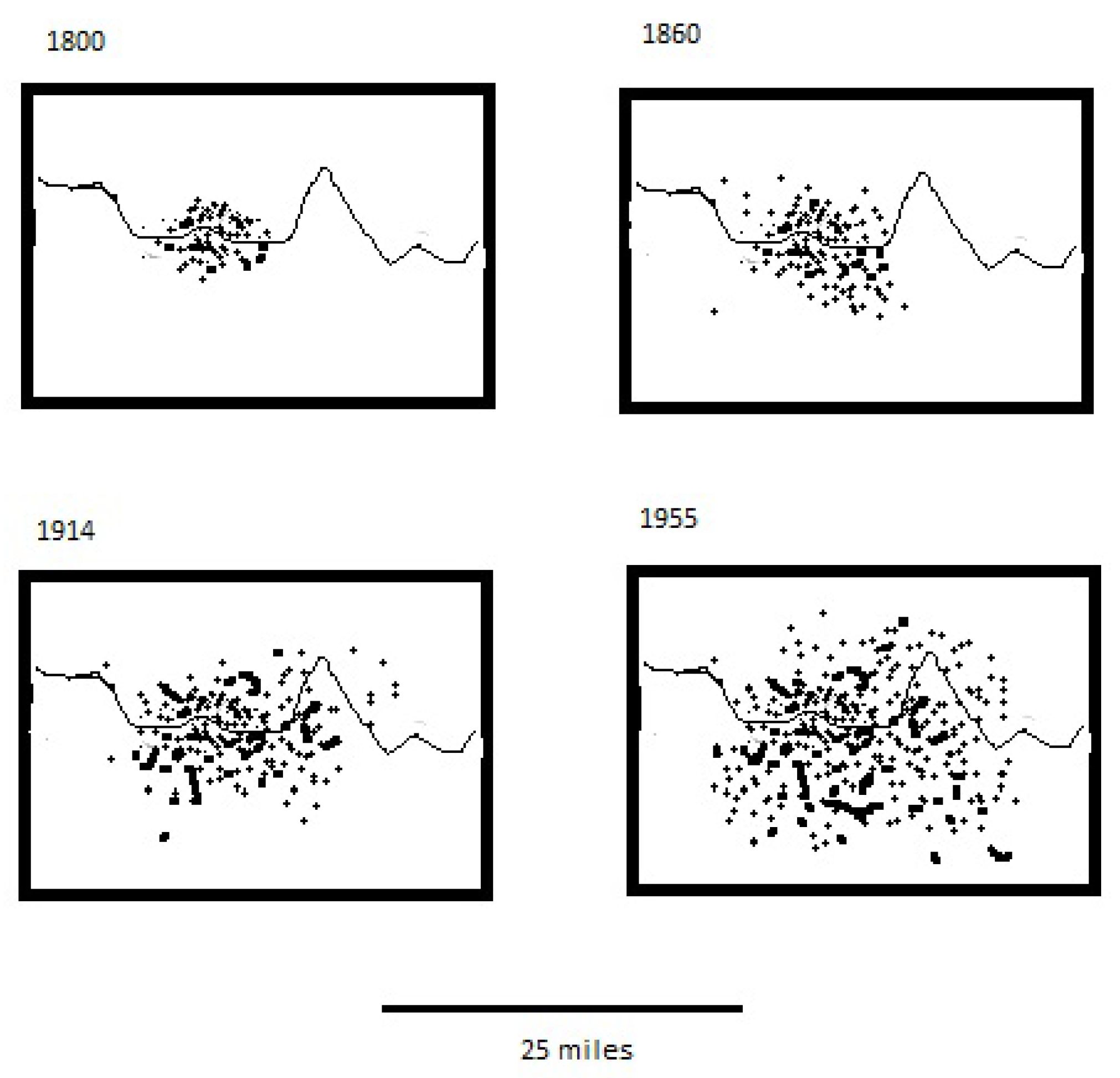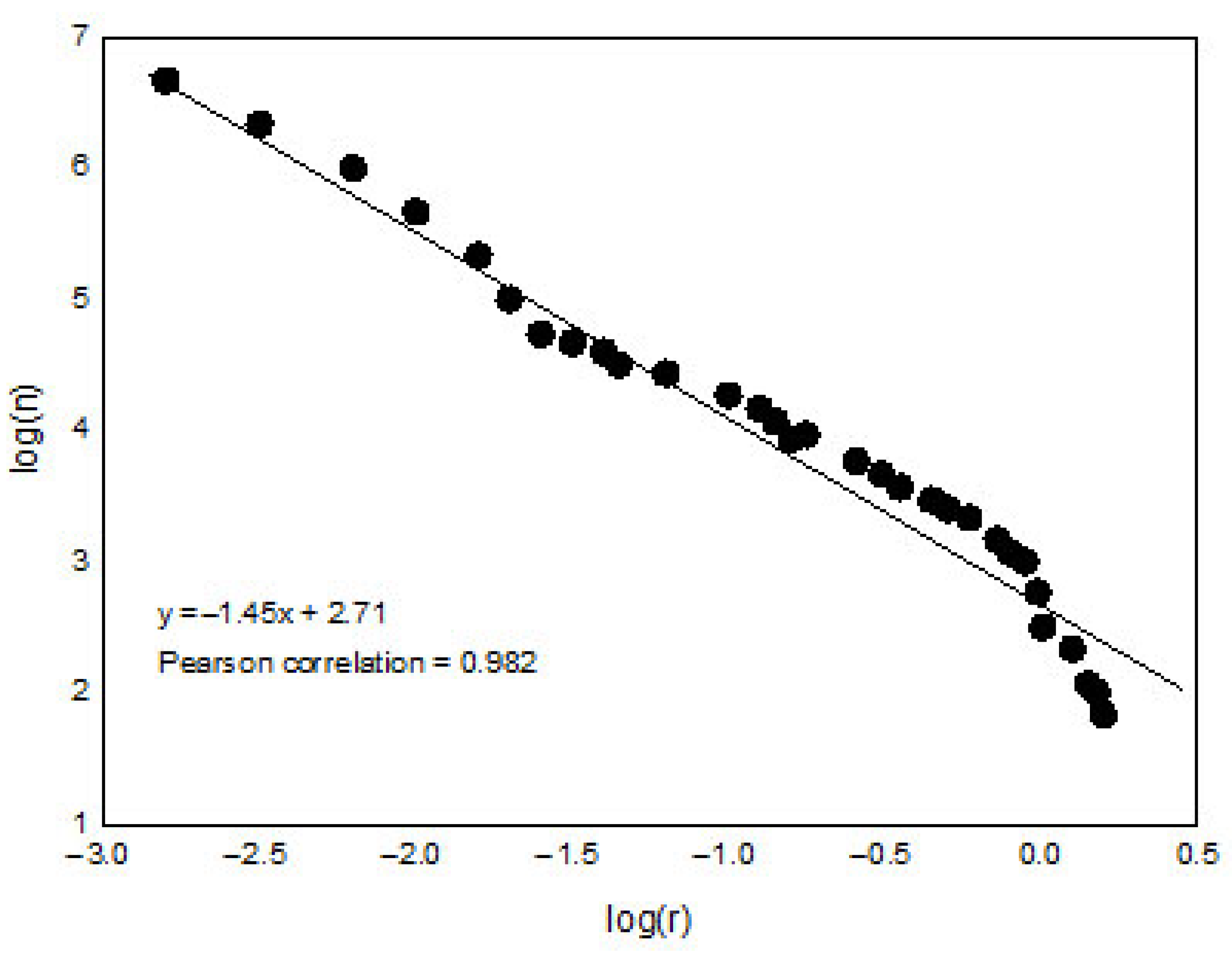Urban Systems Between the Environment, Human Health and Society: An Overview †
Abstract
1. Introduction
2. The City as a Complex Non-Linear System
3. City Boundaries as Dynamic Interfaces
4. False Cities and False Citizens
5. Urbanization Explosion and Metastatic Cities
6. Public Health and Cities
7. Conclusions
Author Contributions
Funding
Data Availability Statement
Conflicts of Interest
References
- Lennox, J.B. Robert Rosen and Relational System Theory: An Overview; Springer: Berlin/Heidelberg, Germany, 2024; ISBN 978-3-031-51115-8. [Google Scholar]
- Mikulecky, D.C. Network thermodynamics and complexity: A transition to relational systems theory. Comput. Chem. 2001, 25, 369–391. [Google Scholar] [CrossRef] [PubMed]
- Giuliani, A. System Science Can Relax the Tension Between Data and Theory. Systems 2024, 12, 474. [Google Scholar] [CrossRef]
- Gorban, A.N.; Smirnova, E.V.; Tyukina, T.A. Correlations, risk and crisis: From physiology to finance. Phys. A Stat. Mech. Its Appl. 2010, 389, 3193–3217. [Google Scholar] [CrossRef]
- Scheffer, M.; Carpenter, S.R.; Lenton, T.; Bascompte, J.; Brock, W.; Dakos, V.; van de Koppel, J.; van de Leemput, I.A.; Levin, S.A.; van Nes, E.H.; et al. Anticipating critical transitions. Science 2012, 338, 344–348. [Google Scholar] [CrossRef] [PubMed]
- Arora, M.; Giuliani, A.; Curtin, P. Biodynamic Interfaces Are Essential for Human-Environment Interactions. Bioessays 2020, 42, e2000017. [Google Scholar] [CrossRef] [PubMed]
- Alberts, B.; Bray, D.; Hopkin, K.; Johnson, A.D.; Lewis, J.; Raff, M.; Roberts, K.; Walter, P. Essential Cell Biology, 4th ed.; Garland Publishing: New York, NY, USA, 2013. [Google Scholar]
- Huang, S.; Soto, A.M.; Sonnenschein, C. The end of the genetic paradigm of cancer. PLoS Biol. 2025, 23, e3003052. [Google Scholar] [CrossRef] [PubMed]
- Nicolis, G.; Prigogine, I. Exploring Complexity: An Introduction; W.H. Freeman and Company: New York, NY, USA, 1989. [Google Scholar]
- Karsenti, E. Self-organization in cell biology: A brief history. Nat. Rev. Mol. Cell Biol. 2008, 9, 255–262. [Google Scholar] [CrossRef] [PubMed]
- Skene, K.R. Systems theory, thermodynamics and life: Integrated thinking across ecology, organization and biological evolution. Biosystems 2024, 236, 105123. [Google Scholar] [CrossRef] [PubMed]
- De Marchi, A. Ecologia Funzionale: l’Ambiente e le sue Dinamiche; Garzant: Milan, Italy, 1992; p. 320. ISBN 9788811598299. [Google Scholar]
- Berry, B.L. Self-Organization in Complex Urban Systems. In Handbook on Entropy, Complexity and Spatial Dynamics: A Rebirth of Theory; Reggiani, A., Schintler, R.A., Kzamansky, D., Patuelli, R., Eds.; Edward Elgar Publishing: Cheltenham, UK, 2021; pp. 162–167. [Google Scholar]
- Mittal, K.M.; Timme, M.; Schröder, M. Efficient self-organization of informal public transport networks. Nat. Commun. 2024, 15, 4910. [Google Scholar] [CrossRef] [PubMed] [PubMed Central]
- Douglas, I. Urban ecology and urban ecosystems: Understanding the links to human health and well-being. Curr. Opin. Environ. Sustain. 2012, 4, 385–392. [Google Scholar] [CrossRef]
- Portugali, J. Complexity, Cognition and the City; Springer: Berlin/Heidelberg, Germany, 2011. [Google Scholar]
- Alberti, M. Cities That Think like Planets: Complexity, Resilience, and Innovation in Hybrid Ecosystems; University of Washington Press: Washington, DC, USA, 2016. [Google Scholar]
- Maddox, D. (Ed.) Are Cities Ecosystems—Analogous to Natural Ones—Of Nature, Infrastructure and People? Does Thinking About Cities in This Way Help Us Think About Urban Design? The Nature of Cities. Available online: www.thenatureofcities.com/2017/06/30/cities-ecosystems-analogous-natural-ones-nature-infrastructure-people-thinking-cities-way-help-us-think-urban-design (accessed on 10 May 2025).
- Bodini, A.; Bondavalli, C.; Allesina, S. Cities as Ecosystems: Functional Similarities and the Quest for Sustainability. In Models of the Ecological Hierarchy: From Molecules to the Ecosphere. Developments in Environmental Modelling; Jordán, F., Jørgensen, S.E., Eds.; Elsevier: Amsterdam, The Netherlands, 2012; Volume 25, pp. 297–318. [Google Scholar]
- Arora, M.; Curtin, P.; Curtin, A.; Austin, C.; Giuliani, A. Environmental Biodynamics: A New Science of How the Environment Interacts with Human Health; Oxford Academic: New York, NY, USA, 2021. [Google Scholar]
- Visentin, C. Le Relazioni Città-Campagna Nella Storia del Paesaggio Agrario Italiano; l’Irrinunciabile Eredità di Emilio Sereni; Silvana Editoriale: Milan, Italy, 2011. [Google Scholar]
- Frumkin, H. Urban sprawl and public health. Public Health Rep. 2002, 117, 201–217. [Google Scholar] [CrossRef] [PubMed] [PubMed Central]
- Los, S. Cities and Landscapes as Symbolic Systems; Artena Anarchist Press: Artena, Italy, 2019; ISBN 8894050513. [Google Scholar]
- Settis, S. Landscape, Constitution, Concrete. In The Battle for the Environment Against Civil Degradation; Einaudi: Turin, Italy, 2010. [Google Scholar]
- Harvey, D. The Right to the City: New Left Review 53, 7th ed.; First Published 2020; Routledge: Abington on Thames, UK, 2008; ISBN 9780429261732. [Google Scholar]
- Fernihough, A.; O’Rourke, K.H. Coal and the European industrial revolution. Econ. J. 2021, 131, 1135–1149. [Google Scholar] [CrossRef]
- Ritchie, H.; Roser, M. Urbanization. Our World Data. 2018. Available online: https://ourworldindata.org. (accessed on 10 May 2025).
- Grimm, N.B.; Faeth, S.H.; Golubiewski, N.E.; Redman, C.L.; Wu, J.; Bai, X.; Briggs, J.M. Global change and the ecology of cities. Science 2008, 319, 756–760. [Google Scholar] [CrossRef]
- Lee, K.; Brumme, Z.L. Operationalizing the One Health approach: The global governance challenges. Health Policy Plan. 2013, 28, 778–785. [Google Scholar] [CrossRef] [PubMed]
- Karimi, A.N.; Ahmadi Shadmehri, M.T.A.; Esmaeili, P.; Dehdar, F. Asymmetric Impacts of Renewable Energy on Human Development: Exploring the Role of Carbon Emissions, Economic Growth, and Urbanization in European Union Countries. J. Knowl. Econ. 2024, 15, 17188–17212. [Google Scholar] [CrossRef]
- Wang, X.; Yao, W.; Luo, Q.; Yun, S. Spatial relationship between ecosystem health and urbanization in coastal mountain city, Qingdao, China. Ecol. Inform. 2024, 79, 102458. [Google Scholar] [CrossRef]
- Ohlrau, R. Garden Cities of yesterday, roots of urban sustainability? Stud. Hist. Gard. Des. Landsc. 2024, 44, 197–215. [Google Scholar] [CrossRef]
- Gürçam, S. Paving the Way for Climate Resilience through Sustainable Urbanization: A Comparative Study. Lectio Soc. 2024, 8, 17–34. [Google Scholar] [CrossRef]
- Childers, D.L.; Cadenasso, M.L.; Grove, J.M.; Marshall, V.; McGrath, B.; Pickett, S.T. An ecology for cities: A transformational nexus of design and ecology to advance climate change resilience and urban sustainability. Sustainability 2015, 7, 3774–3791. [Google Scholar] [CrossRef]
- De Jong, M.; Joss, S.; Schraven, D.; Zhan, C.; Weijnen, M. Sustainable–Smart–Resilient–Low Carbon–Eco–Knowledge Cities: Making Sense of a Multitude of Concepts Promoting Sustainable Urbanization. J. Clean. Prod. 2015, 109, 25–38. [Google Scholar] [CrossRef]
- Whitehead, M. (Re)analysing the sustainable city: Nature, urbanization and the regulation of socio-environmental relations in the UK. Urban Stud. 2003, 40, 1183–1206. [Google Scholar] [CrossRef]
- Hern, W.M. Urban malignancy: Similarity in the fractal dimensions of urban morphology and malignant neoplasms. Int. J. Anthropol. 2008, 23, 1–19. [Google Scholar] [CrossRef]
- Bizzarri, M.; Giuliani, A.; Cucina, A.; D’Anselmi, F.; Soto, A.; Sonnenschein, C. Fractal Analysis in a Systems Biology Approach to Cancer. In Seminars in Cancer Biology; Academic Press: Cambridge, MA, USA, 2011; Volume 21, pp. 175–182. [Google Scholar]
- Chai, D.; Fraedrich, K.; Guan, Y.; Guo, S.; Zhang, C.; Zhu, X. Urbanization and climate change: Insights from eco-hydrological diagnostics. Sci. Total Environ. 2019, 647, 29–36. [Google Scholar]
- UN-Habitat. World Cities Report 2020; United Nations Human Settlements Programme (UN-Habitat): Nairobi, Kenya, 2020. [Google Scholar]
- Kuddus, M.A.; Tynan, E.; McBryde, E. Urbanization: A problem for the rich and the poor? Public Health Rev. 2020, 41, 1. [Google Scholar] [CrossRef] [PubMed] [PubMed Central]
- Fouillet, A.; Rey, G.; Laurent, F.; Pavillon, G.; Bellec, S.; Ghihenneuc-Jouyaux, C.; Clavel, J.; Jougla, E.; Hémon, D. Excess mortality related to the August 2003 heat wave in France. Int. Arch. Occup. Environ. Health 2006, 80, 16–24. [Google Scholar] [CrossRef] [PubMed]
- O’Connor, G.T.; Neas, L.; Vaughn, B.; Kattan, M.; Mitchell, H.; Crain, E.F.; Evans, R.; Gruchalla, R.; Morgan, W.; Stout, J.; et al. Acute respiratory health effects of air pollution on children with asthma in US inner cities. J. Allergy Clin. Immunol. 2008, 121, 1133–1139. [Google Scholar] [CrossRef]
- Tilt, J.H. Urban Nature And Human Physical Health. In Routledge Handbook of Urban Ecology; Douglas, I., Goode, D., Houck, M., Wang, R., Eds.; Routledge: London, UK, 2011. [Google Scholar]
- Wallace, R.; Wallace, D. Resilience and persistence of the synergism of plagues: Stochastic resonance and the ecology of disease, disorder and disinvestment in US urban neighborhoods. Environ. Plan. 1997, 29, 789–804. [Google Scholar] [CrossRef]
- Sassen, S. Expulsions: Brutality and Complexity in the Global Economy; Harvard University Press: Cambridge, MA, USA, 2014. [Google Scholar]
- Ferlay, J.; Shin, H.R.; Bray, F.; Forman, D.; Mathers, C.; Parkin, D.M. Estimates of worldwide burden of cancer in 2008: GLOBOCAN 2008. Int. J. Cancer 2010, 127, 2893–2917. [Google Scholar] [CrossRef] [PubMed]
- Gartner, A.; Farewell, D.; Roach, P.; Dunstan, F. Rural/urban mortality differences in England and Wales and the effect of deprivation adjustment. Soc. Sci. Med. 2011, 72, 1685–1694. [Google Scholar] [CrossRef] [PubMed]
- Schouten, L.J.; Meijer, H.; Huveneers, J.A.; Kiemeney, L.A. Urban-rural differences in cancer incidence in The Netherlands 1989–1991. Int. J. Epidemiol. 1996, 25, 729–736. [Google Scholar] [CrossRef] [PubMed]
- Uccelli, R.; Mastrantonio, M.; Di Paola, M. Distribution of causes of death in municipalities with different levels of urbanization. Epidemiol. Prev. 2000, 24, 28–37. [Google Scholar] [PubMed]
- Singh, G.K.; Siahpush, M.; Williams, S.D. Changing urbanization patterns in US lung cancer mortality, 1950–2007. J. Community Health 2012, 37, 412–420. [Google Scholar] [CrossRef] [PubMed] [PubMed Central]
- Enayatrad, M.; Yavari, P.; Vahedi, H.; Mahdavi, S.; Etemad, K.; Khodakarim, S. Urbanization Levels and Its Association with Prevalence of Risk Factors and Colorectal Cancer Incidence. Iran. J. Public Health 2021, 50, 2317–2325. [Google Scholar] [CrossRef] [PubMed] [PubMed Central]
- Lortet-Tieulent, J.; Georges, D.; Bray, F.; Vaccarella, S. Profiling global cancer incidence and mortality by socioeconomic development. Int. J. Cancer 2020, 147, 3029–3036. [Google Scholar] [CrossRef] [PubMed]
- Dahly, D.L.; Adair, L.S. Quantifying the urban environment: A scale measure of urbanicity outperforms the urban-rural dichotomy. Soc. Sci. Med. 2007, 64, 1407–1419. [Google Scholar] [CrossRef] [PubMed] [PubMed Central]
- Jones, R.L.; Guha-Sapir, D.; Tubeuf, S. Human and Economic Impacts of Natural Disasters: Can We Trust the Global Data? Sci. Data 2022, 9, 572. [Google Scholar] [CrossRef] [PubMed] [PubMed Central]
- Yu, D.; Li, X.; Yu, J.; Shi, X.; Liu, P.; Tian, P. Whether Urbanization Has Intensified the Spread of Infectious Diseases-Renewed Question by the COVID-19 Pandemic. Front. Public Health 2021, 9, 699710. [Google Scholar] [CrossRef] [PubMed] [PubMed Central]
- MEA. A Report of the Millennium Ecosystem Assessment. In Ecosystems and Human Well-Being; Island Press: Washington DC, USA, 2005. [Google Scholar]
- Hakim, B.S. Mediterranean Urbanism: Historic Urban/Building Rules and Processes; Springer: Dordrecht, The Netherlands, 2014. [Google Scholar]
- Neuwirth, R. Shadow Cities: A Billion Squatters, a New Urban World; Routledge: New York, NY, USA, 2005. [Google Scholar]
- al-Sabouni, M. Building for Hope: Towards an Architecture of Belonging; Thames & Hudson: London, UK, 2021. [Google Scholar]
- Dubuc, B.; Zucker, S.W.; Tricot, C.; Quiniou, J.F.; Wehbi, D. Proceedings of the Royal Society of London. Series A, Mathematical and Physical Sciences; Royal Society: London, UK, 1989; Volume 425, pp. 113–127. [Google Scholar]
- Mikulecky, D.C. Robert Rosen (1934–1998): A snapshot of biology’s Newton. Comput. Chem. 2001, 25, 317–327. [Google Scholar] [CrossRef]


Disclaimer/Publisher’s Note: The statements, opinions and data contained in all publications are solely those of the individual author(s) and contributor(s) and not of MDPI and/or the editor(s). MDPI and/or the editor(s) disclaim responsibility for any injury to people or property resulting from any ideas, methods, instructions or products referred to in the content. |
© 2025 by the authors. Licensee MDPI, Basel, Switzerland. This article is an open access article distributed under the terms and conditions of the Creative Commons Attribution (CC BY) license (https://creativecommons.org/licenses/by/4.0/).
Share and Cite
Modonesi, C.; Serafini, S.; Giuliani, A. Urban Systems Between the Environment, Human Health and Society: An Overview. Systems 2025, 13, 487. https://doi.org/10.3390/systems13060487
Modonesi C, Serafini S, Giuliani A. Urban Systems Between the Environment, Human Health and Society: An Overview. Systems. 2025; 13(6):487. https://doi.org/10.3390/systems13060487
Chicago/Turabian StyleModonesi, Carlo, Stefano Serafini, and Alessandro Giuliani. 2025. "Urban Systems Between the Environment, Human Health and Society: An Overview" Systems 13, no. 6: 487. https://doi.org/10.3390/systems13060487
APA StyleModonesi, C., Serafini, S., & Giuliani, A. (2025). Urban Systems Between the Environment, Human Health and Society: An Overview. Systems, 13(6), 487. https://doi.org/10.3390/systems13060487






